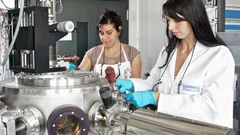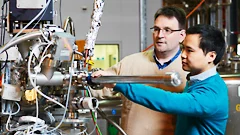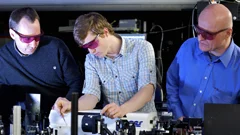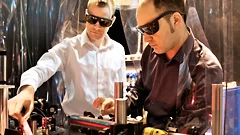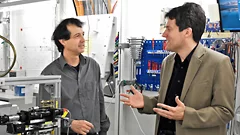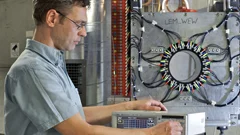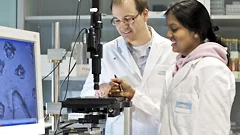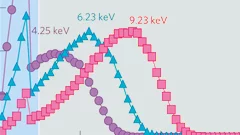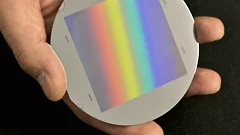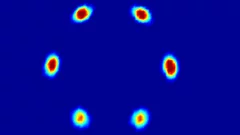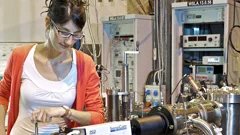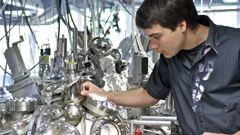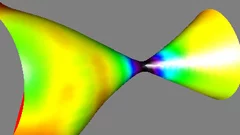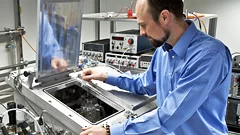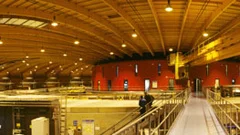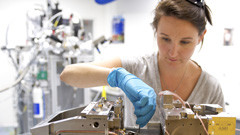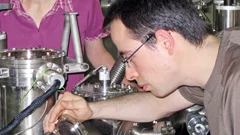Future Technologies
The manifold characteristics of materials are determined by what type of atoms they are made of, how these atoms are arranged, and how they move. In the research area Future Technologies, scientists at the Paul Scherrer Institute are trying to clarify this link between the internal structure and the observable properties of different materials. They want to use this knowledge as fundamental principles for new applications – whether in medicine, information technology or energy generation and storage – or to explore innovative manufacturing processes for industry.
Find out more at: Future Technologies
New Insights into Superconducting Materials
A new X-ray technique provides insights into the magnetic properties of atomically thin layers of a parent compound of a high-temperature superconductor. It turns out that the magnetic properties of material films which are only a few atoms thick differ by only a surprisingly small degree from those of macroscopically thick samples. In the future, this method can be used to study the processes occurring in very thin layers of superconductors and help us to understand this intriguing phenomenon.
Controversy clarified: Why two insulators together can transport electricity
How can two materials which do not conduct electricity create an electrically conducting layer when they are joined together? Since this effect was discovered in 2004, researchers have developed various hypotheses to answer this question. Now, an international team under the leadership of researchers at the Paul Scherrer Institute has probably settled the controversy.
Physicists observe the splitting of an electron inside a solid
An electron has been observed to decay into two separate parts, each carrying a particular property of the electron: a spinon carrying its spin à the property making the electron behave as a tiny compass needle à and an orbiton carrying its orbital moment à which arises from the electron’s motion around the nucleus. These newly created particles, however, cannot leave the material in which they have been produced.
Creating magnetism takes much longer than destroying it
Researchers at the Paul Scherrer Institute are finding out how long it takes to establish magnetism and how this happens. Establishing a magnetically ordered phase in the metallic alloy iron-rhodium takes much longer than the reverse process of demagnetization. The result comes from basic research, but has relevance for the computer industry, as it shows which processes limit the speed of magnetic data storage and where improvements might be made.
Using heat for storing data
An international research team has demonstrated a new way to record information on a magnetic medium without the use of a magnetic field. Instead, they found that they could record information using only a heat pulse. This method of recording might allow one to record Terabytes (1000s of Gigabytes) of information per second being 100s of times faster than present hard drive technology, and consumes much less energy by using heat without the need for a magnetic field. Using modern lithographic methods and x-ray microscopy, researchers from the Paul Scherrer Institute contributed considerably to this work.
It works: Ultrafast magnetic processes observed live
using an X-ray laser
In first-of-their-kind experiments performed at the American X-ray laser LCLS, a collaboration led by researchers from the Paul Scherrer Institute has been able to precisely follow how the magnetic structure of a material changes. The change of structure was initiated by a laser pulse, and investigated with the help of short X-ray pulses. It appears as if the structure begins to change 400 femtoseconds after the laser pulse strikes. Such investigations will be a major focus of research at the planned Swiss X-ray Laser, SwissFEL, at PSI.
Schweiz beteiligt sich an Neutronenquelle der Zukunft
Mauro Dell’Ambrogio, Staatssekretär für Bildung und Forschung unterzeichnete heute die Absichtserklärung der Schweiz, sich an der neuen europäischen Neutronenquelle ESS (European Spallation Source) zu beteiligen. Darin bekennt sich die Schweiz zu dem Ziel, die ESS in Lund (Südschweden) zu bauen und verpflichtet sich, am Konzept mitzuarbeiten, in dem der endgültige Plan für die Anlage festgelegt wird. Kurz nach Fertigstellung des Konzepts im Frühjahr 2013 soll die Entscheidung für den Bau der ESS fallen. Die Schweizer Beiträge zur Entwicklung der Anlage werden durch das Paul Scherrer Institut, das langjährige Erfahrung in der Forschung mit Neutronen hat, sowie durch Schweizer Universitäten und die Schweizer Industrie erbracht.This news release is only available in German.
Zehn Jahre Forschung in der fliegenden Untertasse
Mit einem Festakt hat das Paul Scherrer Institut (PSI) in Villigen (AG) heute an das zehnjährige Bestehen ihrer bedeutendsten Grossforschungsanlage erinnert. Seit der Inbetriebnahme im Sommer 2001 haben Tausende von Forschern aus Hochschule und Industrie an der Synchroton Lichtquelle Schweiz (SLS) qualitativ hochwertige Experimente durchgeführt. Ihre Forschung mündete in über 2000 wissenschaftlichen Publikationen und brachte darüber hinaus einen Nobelpreis sowie eine Vielzahl industrieller Anwendungen hervor.This news release is only available in German.
Der Unterschied zwischen dünn und sehr dünn
Materialforschung in neuer DimensionViele Materialien haben eine spezielle kristalline Struktur à ihre Atome sind übereinander in Schichten angeordnet. Ein deutsch-schweizerisches Forscherteam hat zum ersten Mal präzise beobachtet, wie die physikalischen Eigenschaften einer Substanz von der Zahl dieser Schichten abhängen. Dass sich die physikalischen Charakteristika nun auch auf diese Weise kontrollieren lassen, eröffnet neue Möglichkeiten, Stoffe zu identifizieren, aus denen die Computerchips der Zukunft gemacht sein könnten.This news release is only available in French and German.
The basic structures of sight deciphered
At the beginning of the process of sight, light interacts with a protein molecule called Rhodopsin. This molecule contains the actual light sensor that is stimulated by the incoming light and changes its form, in order to trigger the rest of the process. Researchers have now managed to determine the exact structure of the Rhodopsin molecule in its short-lived, excited state. From this, they have obtained a precise picture of the first step of the process of sight.
In the future: processing and memory on a single chip
Researchers have shown that a magnetically polarised current can be manipulated by electric fields. This important discovery opens up the prospect of simultaneously processing and storing data on electrons held in the molecular structure of computer chips à combining computer memory and processing power on the same chip. This may allow for the development of new devices with high power efficiency and reduced weight.
Magnetisierte Bereiche in 3D sichtbar gemacht
Magnetisierbare Materialien sind nie völlig unmagnetisch, sondern enthalten immer magnetisierte Bereiche à die magnetischen Domänen. In einem Experiment am Helmholtz-Zentrum Berlin (HZB) konnten diese Domänen erstmals in ihrer dreidimensionalen Struktur abgebildet werden. Der Versuch beruhte auf einer Weiterentwicklung eines am Paul Scherrer Institut entstanden Verfahrens und nutzte neutronenoptische Komponenten, die am PSI hergestellt worden sind.This news release is only available in German.
What the “hairy ball theorem” tells us about flux lines in superconductors
In strong magnetic fields, type II superconductors tend to form flux lines à thin channels through which the magnetic field can pass through the superconductor. Usually, these flux lines tend to form regular patterns. Now, two physicists have shown that such a pattern must depend on the direction of the external magnetic field. These results are based on a mathematical principle known as the Hairy ball theorem.
Moving Monopoles Caught on Camera
For decades researchers have searched for magnetic monopoles à isolated magnetic charges that can move freely like electric charges. Now a team of researchers from the Paul Scherrer Institute and University College Dublin have been able to produce monopoles in the form of quasiparticles in an assembly of nanoscale magnets and have directly observed how they move.
A possible new career for a vital biomolecule
As a component of the haemoglobin molecule, porphyrin enables the transport of oxygen within the human body. In a slightly altered form, it may find also applications in technical devices. Researchers at the Paul Scherrer Institute and the University of Basel have shown that a magnetic property of the molecule can be switched on and off by means of a simple chemical procedure, so that the molecule can be used as a tiny molecular switch.
Researchers Find Universal Law For Material Evolution
Many important materials are composed of several phases. When such a material is heated, atoms move from one phase to another, which changes the distribution of the phases à and thus, the properties of the material. A team of researchers has now shown that for an important case, there is a general law describing this process that is valid for all classes of materials.
Understanding plastic semiconductors better
Semiconductors made from polymer materials are becoming increasingly important for the electronics industry à as a basis for transistors, solar cells or LEDs. Usually, they consist of more than one substance as they get their particular electric properties only when several materials are blended. Researchers from the Paul Scherrer Institute and the University of Cambridge have developed a method that allows them to determine the detailed structure of the material.
Magnetspeicher der neusten Generation sind 100 000 mal schneller als herkömmliche Festplatten
Computer-Festplatten könnten bald ausgedient haben: Forscher des Paul Scherrer Instituts PSI und der Universität Konstanz haben neuartige Magnetbänder untersucht und gezeigt, dass sie nicht nur sehr hohe Speicherdichten, sondern auch viel schnellere Zugriffszeiten als heutige Speichermedien zulassen. Leiter der Studie war Mathias Kläui, der am 1. April eine von der ETH Lausanne und dem PSI gemeinsam finanzierte Professur antritt.This news release is only available in French and German.
Aufbau von Materialien nanogenau untersuchen
Ein neues Mikroskop an der Synchrotron Lichtquelle Schweiz SLS des Paul Scherrer Instituts wird es möglich machen, den Aufbau von Materialien mit bisher unerreichter Auflösung darzustellen. Dazu werden Forschende einzelne Bereiche in einem Material betrachten, die nur wenige Nanometer (millionstel Millimeter) gross sind, und für jeden dieser Bereiche bestimmen, welche chemischen Elemente darin enthalten sind.This news release is only available in German.
Controlling the electronic surface properties of a material
Forschenden ist es erstmals gelungen, dünne Schichten mit steuerbaren elektronischen Eigenschaften herzustellen. Diese Entdeckung könnte für zukünftige Anwendungen in der Sensorik und der Computertechnologie von grosser Bedeutung sein. Die Arbeiten wurden im Wissenschaftsmagazin Science veröffentlicht.This news release is only available in German.

